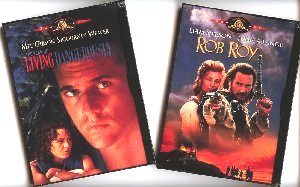| Release List | Reviews | Price Search | Shop | Newsletter | Forum | DVD Giveaways | Blu-Ray/ HD DVD | Advertise |
| Reviews & Columns |
|
Reviews DVD TV on DVD Blu-ray International DVDs Theatrical Reviews by Studio Video Games Features Collector Series DVDs Easter Egg Database Interviews DVD Talk TV DVD Talk Radio Feature Articles Columns Anime Talk DVD Savant HD Talk Horror DVDs Silent DVD
|
DVD Talk Forum |
|
|
| Resources |
|
DVD Price Search Customer Service #'s RCE Info Links |
|
Columns
|
 |
DVD AND 16:9 - HUH? Will THE BIRDCAGE play letterboxed on my conventional 4x3 monitor? On the back of the package it says it is formatted in two versions, pan 'n scan and 16:9 Widescreen. Other DVD's list actual aspect ratios, like 1:85. I only want the movie if it is letterboxed, and can play on my monitor. New formats always come with a confusion factor, and the terminology is where it all begins. Labelling on DVDs has finally reached a level of standardization where you can, if you know how, figure out what kind of picture you will be watching. One of the best features of DVD is its ability to offer more than one playback format, depending on the shape of the screen you want to watch. A film like THE BIRDCAGE is actually digitized twice on the disc, once for a flat pan 'n scan picture, and a second time for letterbox. Previously video, even a laserdisc, was always limited to one or the other. In DVD, once you tell your player what kind of television you have, the letterboxed transfer will be formatted for your screen automatically. So you should have no problem with THE BIRDCAGE. So, what's this 16:9 business? Basically, it is a way to encode a Widescreen video image to maximize quality. The wonderful part of letterboxing is that you retain the correct aspect ratio (or simply, proportional shape) of the image. But one of the drawbacks of letterboxed video is that when you put black bars above and below the image, you are throwing away a sizeable number of your horizontal scan lines that are just showing black screen. Anti-letterboxing zealots actually have a point when they can see actor's faces more clearly in the pan 'n scan copies of films. 16:9 records the image of a Widescreen movie taller and skinnier than it should be, distorting it horizontally. For a standard monitor, the DVD machine plays the video back and reinterprets the digital information to produce a normal letterboxed image. Where 16:9 really pays off is when a Widescreen television is employed. These monitors have screens that mimic the shape of HDTV's. As an aspect ratio, 16:9 works out to 1:77 - a nice compromise if your aim is to show both 'scope and flat movies in their original aspect ratios - narrow black bars top and bottom for 2:35 films, black bars left and right for Academy 1:37 films. For Widescreen 16:9 TV's, the DVD player outputs a full frame, squeezed image, and lets the monitor spread it out sideways. Since the horizontal spread is only about 22%, the picture loses little clarity on that axis. But the number of lines of resolution it gains in the vertical axis* makes it the best video picture going right now. Widescreen 16:9 DVDs greatly surpass laserdisc letterbox quality. By reformatting a flat, Widescreen film like THE BIRDCAGE at 1:77, the 16:9 transfer actually enlarges the image by trimming off the top and bottom of the picture, the same parts that were trimmed away when the film was screened in theaters. An anamorphic Widescreen film such as GOLDENEYE that is even wider than 1:77 will still have black bars at the top and bottom of the picture, but they will be much narrower than on a standard letterbox transfer. To see all of these differences, compare the flat transfers on your DVD's with the letterboxed ones - and, in your setup menu, tell your DVD that you have a 16:9 monitor hooked up just for the test. Then look and see where the same shots are being cropped or opened up in the various formats. As a consumer with a standard flat 4x3 monitor, all you need do is read the DVD labelling to see what versions the particular movie is digitized in: Flat full screen, Flat Pan 'n Scan, Letterbox, and 16:9. The phrase 'Enhanced for Widescreen TVs' has been adopted as a simpler way of designating 16:9. For consumers with Widescreen monitors, it's extremely important because they are the lucky ones who, for Widescreen movies, can see by far the best video image commercially available! ------------------ *A 1:77 letterboxed feature on Laserdisc may waste 30% of the image. No wonder when you blow the image up on a Widescreen TV, the first thing you see is a potentially distracting horizontal line structure. The same 1:77 letterboxed feature mastered on DVD in the squeezed 16:9 format will use all of the available lines of resolution, and be able to display them all in optimal brightness and contrast. Small wonder that 16:9 looks so superior!
Text Copyright ©1998 Glenn Erickson.
Review Staff | About DVD Talk | Newsletter Subscribe | Join DVD Talk Forum |
|
| Release List | Reviews | Price Search | Shop | SUBSCRIBE | Forum | DVD Giveaways | Blu-Ray/ HD DVD | Advertise |





